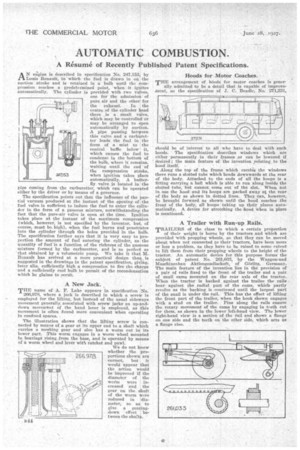AUTOMATIC COMBUSTION.
Page 62

If you've noticed an error in this article please click here to report it so we can fix it.
A Resume of Recently Published Patent Specifications.
• .
AN engine is described in specification No. 247,153, by Louis Renault, in which the fuel is drawn in on the suction stroke and is retained in a bulb until the compression reaches a predetermined point, when it ignites automatically. The cylinder is provided with two valves, one for the admission of pure air and the other for the exhaust. In the
• centre of the cylinder head . there is a small valve, which may he controlled or may be arranged to open automatically by suction. A pipe passing between this valve and a carburetter leads the fuel in the form of a mist to the conical baffle below it, which causes the fuel to condense in the bottom of the bulb, where it remains, waiting until the end of the compression stroke, when ignition takes place automatically. A butterfly valve is located in the pipe coming from the carburetter, which can be operated either by the driver or by means of a governor.
The specification points out that the influence of the partial vacuum produced at the instant of the opening of the fuel valve is sufficient to induce the fuel to enter the cylinder in the form of a gaseous mixture, notwithstanding the fact that the pure-air valve is open at the time. Ignition takes place at the instant of the maximum compression (which, however, is not specified by the inventor, but, of course, must be. high), when the fuel burns and penetrates into the cylinder through the holes provided in the bulb. The specification further says that it is very easy to proportion the amount of fuel entering the cylinder, as the quantity of fuel'is a function of the richness of the gaseous mixture formed by the carburetter, and is as perfect as that obtained by a volumetric pump. We take it that M. Renault has arrived at a more practical design than is suggested in the drawings in the patent specification, giving, inter alia. sufficiently high a compression to fire the charge and a sufficiently cool bulb to permit of the recondensation which he glaims to °emir.
A New Jack.
THE name of A. F. Lake appears in specificatlon No.
26(I,97S, where a jack is described in which a screw is employed for the lifting, but instead of the usual sideways movement generally associated with screw jacks an up-anddown movemtnt of the hand lever is employed, as this movement is often found more convenient when operating in confined spaces.
The illustration shows that the lifting screw is con
nected by means of a gear at its upper end to a shaft which carries a meshing gear and also has a worm cut in its lower part. alis worm engages in a worm wheel mounted in bearings rising from the base, and is operated by means Of a worm wheel and lever with ratchet and pawl.
We do not know
whether the proportions shown are correct, but it would appear that the action would be improved if the diameter of the worm were increased and the gear on the shaft of the worm were reduced in diameter, so as to give a gearingdown effect between the shaftS.
Hoods for Motor Coaches.
THE arrangement of hoods for motor coaches is gener. ally admitted to be a detail that is capable of improveanent, so the specification of S. C. Beadle, Na. 271,231,
should be of interest to all who have to deal with such hoods. The specification describes windows which are either permanently in their frames or can be lowered if desired ; the main feature of the invention relating to the hood itself.
Along the tap af the frame which carries the windows there runs a slotted tube which bends downwards at the rear of the body. Attached to the ends of all the hoops is a fitting earrying a ball which is able to run along inside the slotted tube, but cannot come out of the slot. When not in use the hood and its hnops are packed away at the rear of the body as shown in dotted lines. They can, however, be brought forward as shown until the hood reaches the front of the body, all hoops taking up their places automatically. A device for stretching the hood when in place is mentioned.
A Trailer with Run-up Rails.
TRAILERS of the class to which a certain proportion
of their weight is borne by the tractors and which are Provided with propping wheels, so that they can be moved about when not connected to their tractors, have been more or less a problem, as they have to be raised to some extent to lift them from their propping wheels to the height of the tractor. An automatic device for this purpose forms the subject of patent Na. 261,022, by the Waggonund Maschinenbau Aktiengesellschaft, of Gorlitz, Germany. The main feature of the invention lies in the provision of a pair of rails fixed to the front of the trailer and a pair of snail cams mounted on the rear axle of the tractor. When the tractor is backed against the trailer the rails bear against the radial part of the cams, which partly revolve as the backing is continued until the largest part of the snail is under the rail. This has the effect of lifting the front part of the trailer, when the hook shown engages with a stud on the trailer. Pins along the rails ensure the rotary movement of the cams by engaging in teeth cut for them, as shown in the lower left-hand view. The lower right-hand view -IS a section of the rail and shows a flange on one side and the teeth on the other side, which acts as a flange also.




































































































